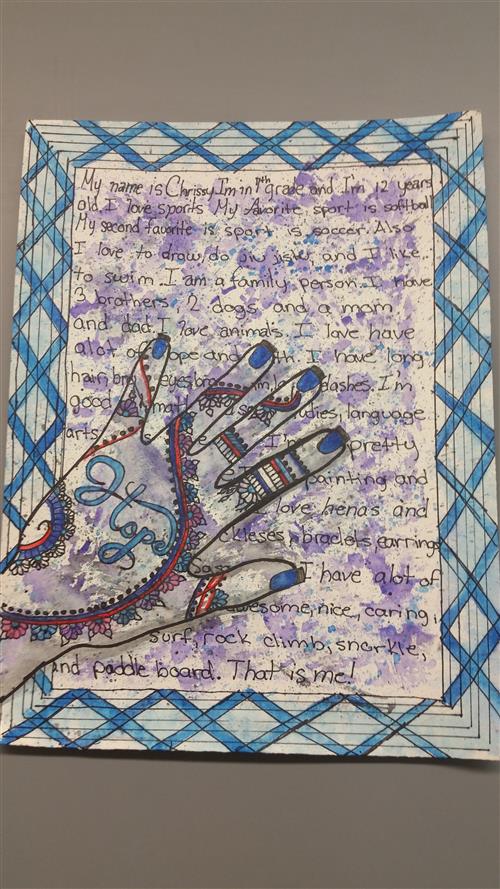ART
Student Art Work

JMMS Art Program
The JMMS Art and Photography program works to support student work in the development of the art standards. Below are the standards utilized at JMMS to complete art and photography curriculum.
1.0 ARTISTIC PERCEPTION
Processing, Analyzing, and Responding to Sensory Information Through the Language and Skills Unique to the Visual Arts
Students perceive and respond to works of art, objects in nature, events, and the environment. They also use the vocabulary of the visual arts to express their observations.
DEVELOP PERCEPTUAL SKILLS AND VISUAL ARTS VOCABULARY
1.1 Use artistic terms when describing the intent and content of works of art.
ANALYZE ART ELEMENTS AND PRINCIPLES OF DESIGN
1.2 Analyze and justify how their artistic choices contribute to the expressive quality of their own works of art.
1.3 Analyze the use of the elements of art and the principles of design as they relate to meaning in video, film, or electronic media.
2.0 CREATIVE EXPRESSION
Creating, Performing, and Participating in the Visual Arts
Students apply artistic processes and skills, using a variety of media to communicate meaning and intent in original works of art.
SKILLS, PROCESSES, MATERIALS, AND TOOLS
2.1 Demonstrate an increased knowledge of technical skills in using more complex two-dimensional art media and processes (e.g., printing press, silk screening, computer graphics software).
2.2 Design and create maquettes for three-dimensional sculptures.
COMMUNICATION AND EXPRESSION THROUGH ORIGINAL WORKS OF ART
2.3 Create an original work of art, using film, photography, computer graphics, or video.
2.4 Design and create an expressive figurative sculpture.
2.5 Select a medium to use to communicate a theme in a series of works of art.
2.6 Design and create both additive and subtractive sculptures.
2.7 Design a work of public art appropriate to and reflecting a location.
3.0 HISTORICAL AND CULTURAL CONTEXT
Understanding the Historical Contributions and Cultural Dimensions of the Visual Arts
Students analyze the role and development of the visual arts in past and present cultures throughout the world, noting human diversity as it relates to the visual arts and artists.
ROLE AND DEVELOPMENT OF THE VISUAL ARTS
3.1 Examine and describe or report on the role of a work of art created to make a social comment or protest social conditions.
3.2 Compare, contrast, and analyze styles of art from a variety of times and places in Western and non-Western cultures.
DIVERSITY OF THE VISUAL ARTS
3.3 Identify major works of art created by women and describe the impact of those works on society at that time.
3.4 Discuss the contributions of various immigrant cultures to the art of a particular society.
4.0 AESTHETIC VALUING
Responding to, Analyzing, and Making Judgments About Works in the Visual Arts
Students analyze, assess, and derive meaning from works of art, including their own, according to the elements of art, the principles of design, and aesthetic qualities.
DERIVE MEANING
4.1 Define their own points of view and investigate the effects on their interpretation of art from cultures other than their own.
4.2 Develop a theory about the artist's intent in a series of works of art, using reasoned statements to support personal opinions.
4.3 Construct an interpretation of a work of art based on the form and content of the work.
MAKE INFORMED JUDGMENTS
4.4 Develop and apply a set of criteria as individuals or in groups to assess and critique works of art.
4.5 Present a reasoned argument about the artistic value of a work of art and respond to the arguments put forward by others within a classroom setting.
4.6 Select a grouping of their own works of art that reflects growth over time and describe the progression.
5.0 CONNECTIONS, RELATIONSHIPS, APPLICATIONS
Connecting and Applying What Is Learned in the Visual Arts to Other Art Forms and Subject Areas and to Careers
Students apply what they learn in the visual arts across subject areas. They develop competencies and creative skills in problem solving, communication, and management of time and resources that contribute to lifelong learning and career skills. They also learn about careers in and related to the visual arts.
CONNECTIONS AND APPLICATIONS
5.1 Select a favorite artist and some of his or her works of art and create a music video that expresses personal ideas and views about the artist.
5.2 Create a painting, satirical drawing, or editorial cartoon that expresses personal opinions about current social or political issues.
VISUAL LITERACY
5.3 Demonstrate an understanding of the effects of visual communication media (e.g., television, music videos, film, Internet) on all aspects of society.
CAREERS AND CAREER-RELATED SKILLS
5.4 Work collaboratively with a community artist to create a work of art, such as a mural, and write a report about the skills needed to become a professional artist.
